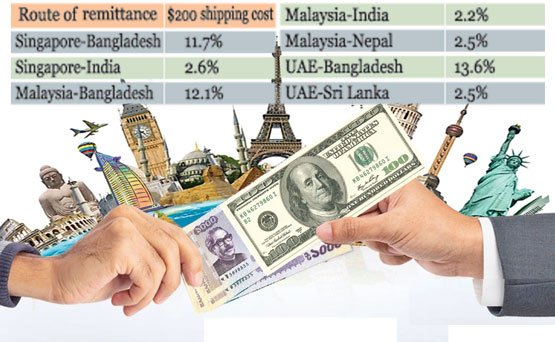Bangladeshi expats pay highest remittance charges
Mahfuz Emran: Bangladesh received $22.168 billion of remittances last year, which is the second highest in the country’s history. Last year, remittance flows to the country increased by more than three percent. However, the cost of expatriates to send this remittance has increased a lot. Especially in the last quarter of last year (October-December) the expenditure increased more. Besides, the cost of sending remittance to Bangladesh is much higher than that of South Asian countries.
This information has emerged in the recent report of ‘The Global Knowledge Partnership on Migration and Development’ or NOMAD, which works on global migration. The report titled ‘Remittances Grown in 2023, Expected to Grow Faster in 2024’ by this organization, a partner of the World Bank, has highlighted the comparative cost of sending $200 to different countries around the world.
It can be seen that the cost of sending remittances has increased in the last quarter of last year compared to the last quarter of 2022 in South Asian countries. Out of this, the cost of sending remittances from UAE to Bangladesh has increased the most. In addition, three of the five most expensive routes for remittances to South Asian countries are Bangladesh. These are Singapore-Bangladesh, Malaysia-Bangladesh and UAE and United Arab Emirates-Bangladesh.
According to the report, the cost of sending $200 from Singapore to Bangladesh in the last quarter of 2022 was eight percent or $16. In the last quarter last year, it increased to 11.7 percent or $23.4. However, the cost of sending remittances from Singapore to Indian expatriates is relatively low. Last year, only 2.6 percent or $5.2 dollars was spent by Indian expatriates to send $200 dollars on this route. That means sending remittances from Singapore to Bangladesh is four and a half times more expensive than India.
Meanwhile, in the last quarter of 2022, the cost of sending $200 from Malaysia to Bangladesh was 8.5 percent or $17. In the last quarter last year, it increased to 12.1 percent or $24.2. However, the cost of sending remittances from Malaysia to expatriates in India or Nepal is relatively low. Last year it further decreased.
In the last quarter of last year, it cost only 2.2 percent or $4.4 for Indian diaspora to send $200 on this route. And the expatriates of Nepal have spent two and a half percent or five dollars on this route. In other words, sending remittances from Malaysia to Bangladesh is five and a half times more expensive than India. The expenditure is 4.84 percent higher than that of Nepal.
On the other hand, the cost of sending $200 from UAE to Bangladesh in the last quarter of 2022 was five percent or $10. In the last quarter last year, it increased to 13.6 percent or $27.2. That is, the cost has tripled in one jump. However, the cost of sending remittances from UAE to Sri Lankan expatriates is the lowest in South Asia. Last year Sri Lankan expatriates spent only 2.5 percent or $5 to send $200 on this route. That means sending remittances from UAE to Sri Lanka is about six times more expensive.
When asked about this, Bangladesh Bank Executive Director and Spokesperson Majbaul Haque told, “Most of our remittances come through foreign exchange houses. We don’t have any exchange houses in the Middle East. So, you have to rely on foreign exchange houses. That’s why almost everyone increases their spending as they wish. We have no hand in it. However, we are trying to increase the exchange house in the Middle East. Then the cost of remittance can be reduced a lot.
Incidentally, Bangladesh was ranked seventh in the world in remittance collection last year. Earlier in 2021, Bangladesh received the highest remittance, amounting to $22.206 billion. Then in 2022 it decreased by 3.16 percent to $21.505 billion. But last year it increased again by 3.08 percent.
Data analysis shows that the first remittance flow in the country’s history exceeded $ 5 billion in 2006. After three years in 2009, it released $10 billion. However, remittance flow of $15 billion has to wait for six years. In 2015, the remittance flow stood at $15.296 billion. However, in the next two years (2016 and 2017) it again fell to $13 billion.
In 2018, remittance flows again exceeded $15 billion. In 2019, it increased to $18.364 billion. In 2020 it exceeded $21 billion. That year, remittances reached $21.752 billion. Mainly due to Corona, many expatriates started sending their savings back home, resulting in high remittances for two consecutive years. It exceeds $22 billion in 2021.
Rare Israeli airstrike in Beirut kills Hezbollah commander and more than a dozen others
International Desk: Israel launched a rare airstrike that killed a senior Hezbollah milita…








